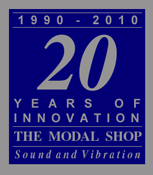|
Tip of the Month
|
When operating daily accelerometer calibrations pay close attention to securing the Sensor-Under-Test signal cable. A short, yet strain free secured service loop will:
- Reduce strain effects and spurious output at very low frequencies (<5 Hz), as well as resonances at very high frequencies (>15 kHz).
- Ensure more consistent calibrations run to run for better random uncertainty.
- Enable longer useable life for the calibration Sensor-Under-Test signal cable.
|
| Quick Links |
ISO TC 108 - Mechanical vibration, shock and condition monitoring
ISO TC 108/SC 3 - Use and calibration of vibration and shock measuring instruments
SAVIAC
|
| Select Newsletter Articles by Topic | |
|
|
|
|
Benefits of Understanding ICP® Sensor Bias...
| |
I'm always pleased and surprised by the positive response we get when offering information on the basics of dynamic sensing.
With that in mind, here's another vintage mini "applet" by Jim Lally.
Whether you use old-school blue boxes with an analog meter, rack power with a bias LED or ICP® built-in to your multichannel Dynamic Signal Analyzer, this slightly updated version covers the basics of the "Benefits of Monitoring and Understanding ICP Sensor Bias"...
Click here to read more
http://www.modalshop.com/calibration.asp?ID=652
|
The Devil is in Accelerometer Calibration Details
| |
When seeking the best uncertainties and most consistent daily verification and operation of your  accelerometer calibration system, it pays to know your sensor's details. The key to accelerometer calibration is ensuring that everything starts from a "flat line." This means no relative motion between Reference Accelerometer and Sensor-Under-Test, as well as no local resonances and strain effects from connectors and cables. accelerometer calibration system, it pays to know your sensor's details. The key to accelerometer calibration is ensuring that everything starts from a "flat line." This means no relative motion between Reference Accelerometer and Sensor-Under-Test, as well as no local resonances and strain effects from connectors and cables.
The practical keys to this are...
Click here to read more
http://www.modalshop.com/calibration.asp?ID=653
|
|
Blast from the Past
| |
For those who may be new to our newsletter, we wanted to highlight an article from a previous sensor & calibration tips - "Relative Motion in Calibration Shakers"...
In the back-to-back calibration method, the known sensitivity of the reference accelerometer combined with its measured output is used to determine the acceleration level of the shaker. This information combined with the measured output of the Sensor-Under-Test (SUT) is used to determine the SUT sensitivity thus completing the calibration. The obvious, yet sometimes overlooked assumption in this method is that both sensors are subjected to the same acceleration input, bringing up the topic of this month's column.
Click here to read more
http://www.modalshop.com/calibration.asp?ID=224
|
| |
Again, we appreciate your interest and are glad to be providing regular information to help you with your dynamic testing and calibration needs.
Sincerely,
|
 Michael J. Lally A PCB Group Company
| |